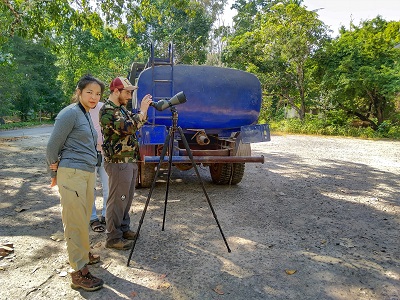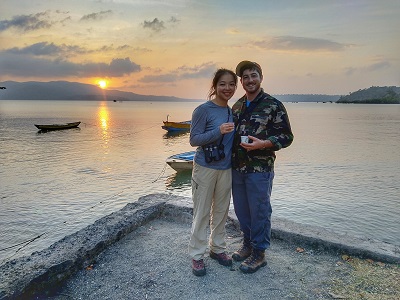Birdwatching in Port Blair: A Full Day Birding in South Andaman
I received a phone call from Samuel Snow who arrived at Port Blair with his wife Lily from the US. He saw our advertisement on go2andaman travel maps. And booked me for a half day birding in Port Blair tour for the following day. Next morning, I picked them up at 0515hrs.
Endemic Birds of Andaman: Forest Birding
We headed south to South Andaman’s southernmost secondary deciduous forest, Chidiyatapu. It’s one of my favourite spots in South Andaman for bird watching since, as the name implies, it’s packed with birds. Just past Burmanallah, we made our first halt at a little mangrove clump. Here, we saw Chinese pond herons, striated herons, and collared and white-throated kingfishers. We saw more than 50 white-rumped munias grazing on a rice field some distance ahead. At a little dam with some forest clearing, we came to a stop. Here, the andaman cuckooshrike, an endemic, was seen together with white-headed starlings, andaman shamas, andaman flowerpeckers.
As we continued down the road, we were immediately rewarded with the sight of a pair of Andaman bulbuls feasting indifferent to our presence. The Andaman woodpecker’s loud pounding caught our attention. We looked for the bird for a long time, but we were unable to find it. Instead, we discovered a mixed feeding flock of Andaman treepies, Andaman drongos, Greater racket-tailed Drongos, and Black-naped Monarchs. Despite being far inside the canopy, the woodpecker’s drumming was still audible to us. A forest wagtail flew off before anyone could get a good look, and farther on we saw Emerald Doves eating on the road. A female Andaman Woodpecker was eventually observed drumming on a dry branch before we left the forest area for breakfast.

Searching for Forest birds

Our breakfast was interrupted by an olive-backed sunbird feeding on the nearby coconut tree. We watched the bird while sipping our ginger tea. Meanwhile, in nearby mangroves, saw found Eastern yellow wagtail and Taiga flycatcher. We then headed towards the Biological Park at Chidiyatapu which opens only at 0900hrs. As we waited for the park to open its gates, we saw a flock of Long-tailed Parakeets. Later at the entrance of the park, we found andaman shama, andaman treepie, black-naped monarchs and orange-headed thrush. Further ahead, we noticed an andaman green pigeon flying in disappearing on a padauk tree.
After some searching, we managed to scope the bird for some good views. On our way back, we stopped again at the same mangroves at Burmanallah, this time, we found a stork-billed kingfisher and few blue-tailed bee-eaters on the electric wire. Along the shore, we saw pacific reef heron and whimbrel. Sam & Lily who initially opted for a half day tour decided to cancel their sightseeing plan and extended to a full bay birding in Port Blair as well for Owl Watching.
Click here for the complete checklist.
Wetland Birding in Port Blair
At 1415hrs, we drove to Sippighat wetlands for our afternoon birding in Port Blair. Upon arrival, we noticed a slaty-breasted rail and a Pin-tailed snipe feeding. Walking along the gravel road produced yellow and cinnamon bitterns, a white-browed crake (a vagrant in Andaman), and our primary target, andaman teals. While returning, a eurasian wryneck flew by and landed on a nearby tree, another uncommon species for the islands and a lifer for Sam, who had earlier failed to spot the bird in the United States or elsewhere in the world. We continued on to a nearby mudflat, to see red-necked and long-toed stints, pacific swallows, white-bellied sea-eagles, and curlew sandpipers. At 1600hrs, we left Sippighat for Chidiyatapu.
Click here for the complete checklist.

Owl watching in Port Blair
We arrived at Chidiyatapu just in time to enjoy tea while watching the sun set. Tourists who come to see the same are frequently in the area. As a result, we had to wait until the crowd dissipated before the owls emerged to hunt.
The Walden’s scops owl, an andaman subspecies of the oriental scops owl, was the first species we saw, but the views weren’t very good. We decided to move on and search for the hawk owls. A few minutes after, the hume’s hawk owl was spotted perched 5 meters away from us, the andaman hawk owl was observed on a dead tree next to the road. We visited the Waldens once more, but this time we got very good views.
We stopped within the woodland patch on the way back to look for the andaman scops owl, which is a forest dweller. Could hear 4 individuals calling from a distance, but due to the dense canopy, couldn’t see them. By 2015 hrs. I called it a night and dropped them back in the hotel.
Click here for the complete checklist.c

Over the course of our full day of birding in Port Blair, we spotted around 90 species which included 14 of the 20 endemics found in Andaman Islands including some uncommon birds like eurasian wryneck and white-browed crake.
Click here for details about our full day and half day tour or email us to learn more.

